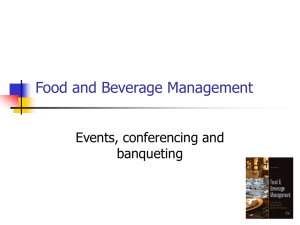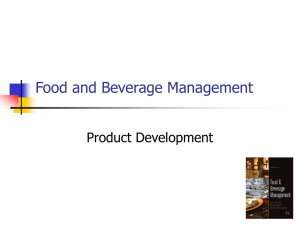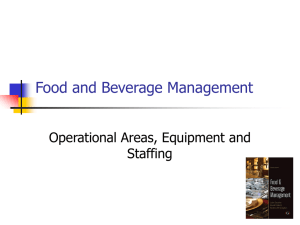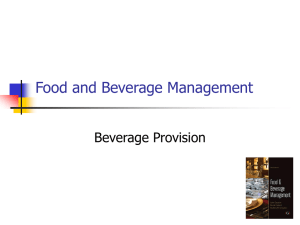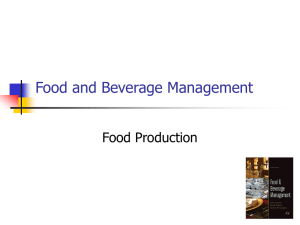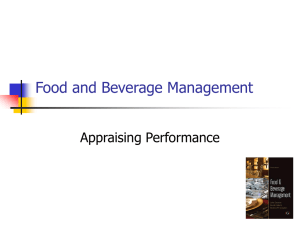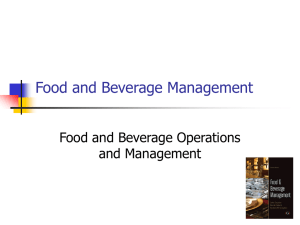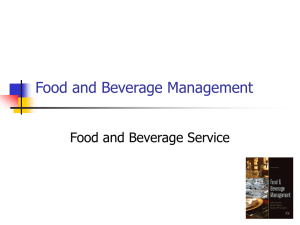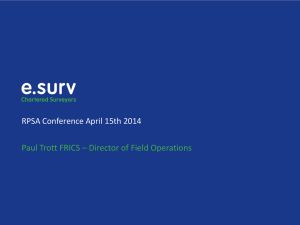Food and Beverage Managment 3rd Edition 2011
advertisement
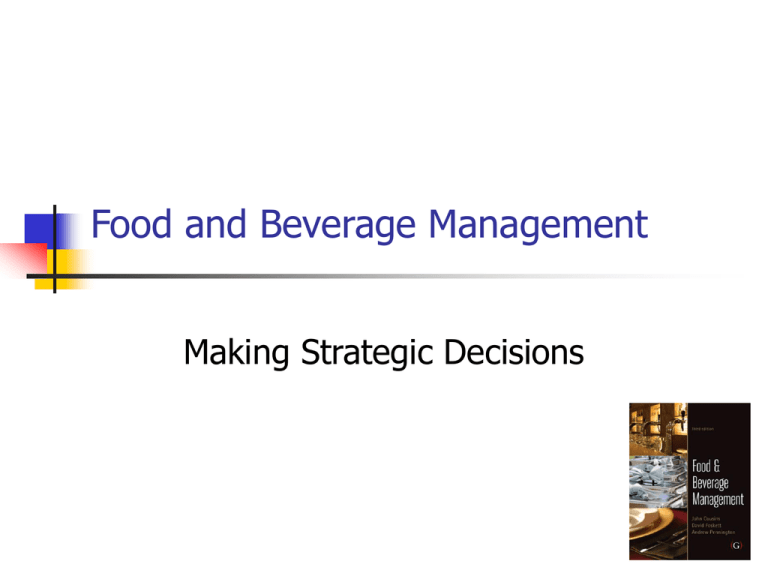
Food and Beverage Management Making Strategic Decisions Origins of strategy Vision Mission Policy Goals/aims Strategy Objectives Tactics © 2011 Cousins et al: Food and Beverage Management, 3rd edition, Goodfellows Publishers The three levels of strategy © 2011 Cousins et al: Food and Beverage Management, 3rd edition, Goodfellows Publishers Assessing current performance 1. Same three levels used when assessing the performance of the current operation: Operational 2. Business 3. includes day-to-day sales and the way the product is provided and promoted the performance of the enterprise in terms of profitability, competitiveness and other business measures Corporate the strategic direction of the operation and how this is being achieved © 2011 Cousins et al: Food and Beverage Management, 3rd edition, Goodfellows Publishers Assessing current performance Quantitative analysis Business environment analysis Qualitative evaluation © 2011 Cousins et al: Food and Beverage Management, 3rd edition, Goodfellows Publishers Quantitative analysis Essential part of appraisal Considered over time Evaluation is more important than the data itself © 2011 Cousins et al: Food and Beverage Management, 3rd edition, Goodfellows Publishers Business environment appraisal Macro environment PESTLE Industry environment Five forces © 2011 Cousins et al: Food and Beverage Management, 3rd edition, Goodfellows Publishers The business environment P E S T L E Political Economic Socio-cultural Technological Legal Ecological © 2011 Cousins et al: Food and Beverage Management, 3rd edition, Goodfellows Publishers The micro-environment Porter’s Five Forces Adapted from Porter 2004 © 2011 Cousins et al: Food and Beverage Management, 3rd edition, Goodfellows Publishers Qualitative evaluation Making informed evaluation of the business Allowing for external comparison Asking the right questions © 2011 Cousins et al: Food and Beverage Management, 3rd edition, Goodfellows Publishers The foodservice cycle © 2011 Cousins et al: Food and Beverage Management, 3rd edition, Goodfellows Publishers The foodservice cycle Can be used to as an analysis tool for the operation: Difficulties in one element of the cycle will cause difficulties in the elements of the cycle that follow Difficulties experienced under one element of the cycle will have their causes in preceding elements © 2011 Cousins et al: Food and Beverage Management, 3rd edition, Goodfellows Publishers Assessing organisational capability Resource analysis How well do we do what we do? Existing capacity for change Identifying changes in resources Value chain analysis Examine all stages of the foodservice cycle © 2011 Cousins et al: Food and Beverage Management, 3rd edition, Goodfellows Publishers SWOT matrix © 2011 Cousins et al: Food and Beverage Management, 3rd edition, Goodfellows Publishers Strategy is a means to an end “Would you tell me please which way I ought to go from here?” she asked. “That depends a good deal on where you want to get to,” said the cat. Lewis Carroll, Alice’s Adventures in Wonderland © 2011 Cousins et al: Food and Beverage Management, 3rd edition, Goodfellows Publishers Strategy is a means to an end Where do Where are you want to you starting get to? from? Which way ought I to go? Objective Strategy Current situation © 2011 Cousins et al: Food and Beverage Management, 3rd edition, Goodfellows Publishers Basis of strategy Cost leadership Differentiation Focus based on cost Focus based on differentiation © 2011 Cousins et al: Food and Beverage Management, 3rd edition, Goodfellows Publishers Porter’s matrix Competitive advantage Low cost Broad Target Differentiation 1 Cost leadership 2 Differentiation 3A Cost focus 3B Differentiation focus Competitive scope Narrow Target Adapted from Porter 2004 © 2011 Cousins et al: Food and Beverage Management, 3rd edition, Goodfellows Publishers Eight possible strategic routes Strategy Clock Adapted from Johnson et at 2010 © 2011 Cousins et al: Food and Beverage Management, 3rd edition, Goodfellows Publishers Determining strategic choices Various approaches can assist, including: Growth Share (BCG) Matrix Directional Policy (GE-McKinsey) Matrix Ansoff’s growth matrix © 2011 Cousins et al: Food and Beverage Management, 3rd edition, Goodfellows Publishers Ansoff’s growth matrix Adapted from Ansoff 1988 © 2011 Cousins et al: Food and Beverage Management, 3rd edition, Goodfellows Publishers Life cycle analysis Stages Market position Embryonic – Growth – Mature - Aging Dominant – Strong – Favourable – Tenable – Weak Variants Fad life cycle Extended life cycle © 2011 Cousins et al: Food and Beverage Management, 3rd edition, Goodfellows Publishers Strategic means and assessing options Strategic means Internal development Mergers and acquisitions Joint development Assessing options Suitability Feasibility Acceptability © 2011 Cousins et al: Food and Beverage Management, 3rd edition, Goodfellows Publishers Reality of strategic management Organic not linear Affected by organisation and culture Complex and judgmental Continuous process Combines a variety of approaches A management job Needs to be flexible to cope with uncertainty © 2011 Cousins et al: Food and Beverage Management, 3rd edition, Goodfellows Publishers
